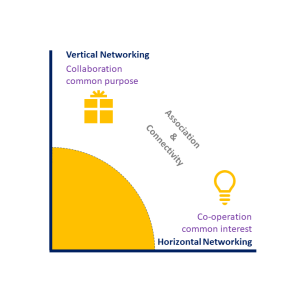This presentation is useful for thinking about the difference between collaborative and co-operative learning. My interest in social media for learning, studio-based learning, and hybrid learning centres on how people work and learn together. They often return to ‘working alongside’ (co-operation) and purposefully working together (collaboration). It comes down to goals ultimately and the meaning of an association to those involved in it.
These distinctions help us to think about learning design and learner motivation in active learning.
Daniel Bassill presents a more global view as he discusses examples of horizontal and vertical networks, but I think the ideas help to clarify associative networks working in a more granular way too. It should be noted that the idea presents a binary. As is usually (always?) the case, binary presentations are useful for presenting ideas conceptually but, in reality, practice tends to exist on a continuum.
Horizontal networks
As I understand it, the unifying factor of a horizontal network is its common interest. The network becomes visible in an event or a place. People network around a topic, but are not focused on a specific goal. Horizontal networks consist of people who have different personal or organisational agendas, so there is sometimes verticality nested within the horizontal. In a horizontal network there may be vertical groupings, for example made up of people from a single organisation who attend a conference with the aim of learning something that will help them achieve their project by drawing upon ideas or experience from across a broader horizontal network. A special interest group is a good example of this where people may represent organisations and be involved in leading an organisational change, but they come together giving their respective work a common validity and accommodating serendipity, and sharing specific successes, and comparing different experiences.
In teaching and learning, people create a sense of place by being together and sharing ideas and commitment. A learning studio exemplifies this idea of learning alongside each other as co-operators. The art student’s goal is their picture, but their co-presence alongside their peers reinforces their cultural identity and personal motivation.
Vertical networks
In a vertical network the unifying factor is a vision, shared purpose, or goal. People work together on a common problem towards a single solution in joint enterprise.
In such networks people are interested in the overarching topic and in applying ideas and knowledge as a collaboration for making a better world.
In teaching and learning, students enact vertical learning in group work, for example in project-based learning, problem-based learning, or team-based learning assignments. They collaborate to make a collective object (e.g. report, presentation, prototype).
Crossing the boundaries – benchmarking
As noted, the convergence of the horizontal is interesting from a learning and teaching perspective. This is seen in acts of discussion and presentation for example, where one group asks another for feedback or where a ‘show and tell’ or ‘crit’ activity is used. Such connecting activities affect the motivation and reflective thinking of students as they compare their own ideas to those of their peers.
This crossing of the horizontal and vertical space should result in a race to the top in which competition finds spaces within a co-operative space.

